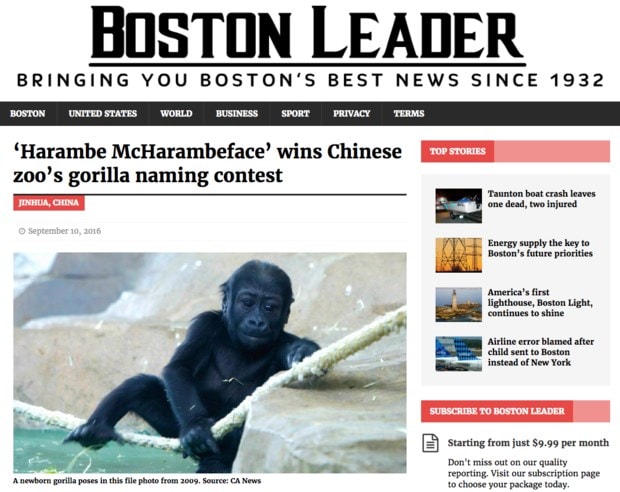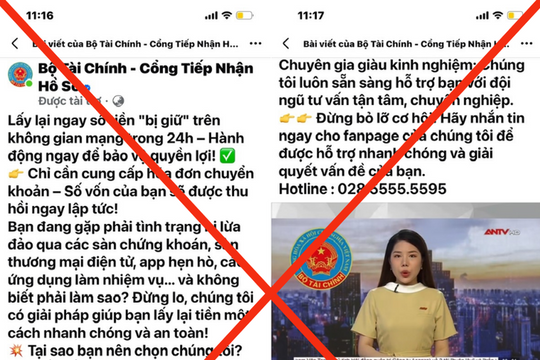Debunking fake news stories for the sake of journalism
Fake news is not only poor quality, but also spreads false information that readers often only consider at the surface.
Some editors believe that the responsibility for exposing fake news lies with newsrooms, as it threatens readers' trust in the media when no one challenges it.
The question of what to do with fake news and misinformation continues to grapple with editors around the world.
That's why First Draft News launched a partnership network this week to connect newsrooms and social media platforms to tackle issues of trust and truth in journalism.
First Draft News is the product of a coalition committed to raising standards of digital journalism, focusing on verifying information on the ground and debunking fake news stories.
 |
| Fake news from The Leader Boston. (Source: wan-ifra.org) |
The initiative involves Twitter, Facebook, and newsrooms around the world. Through this collaboration, they hope to find solutions to verification processes, live communication, accuracy in social media, and trust in the media.
Fake news attracts a lot of attention
Fake news sites and social media accounts make it more difficult to distinguish between real and fake, especially since many fake news sites look and feel very similar to traditional news websites.
Alastair Reid, managing editor of First Draft News, told the World Editors Forum that fake news stories can have a huge impact, as many people get their news from social media.
If fake news appeared on a timeline next to a story from, say, the Washington Post, people might not notice the difference.
Craig Silverman, editor of BuzzFeed Canada, analyzed two studies on the issue and concluded that it takes more than 12 hours for a fake news story to be exposed online.
In 2015, Silverman published an article for the Tow Center for Digital Journalism called "Outright Lies and Contagious Content: How News Sites Spread (and Debunk) Online Rumors, Unverified Claims, and Misinformation."
In this article, Silverman pointed out 10 news reports that exposed fake news about an artist in the UK in 2014. The total number of shares of these 10 news reports was 60,953, but the fake news alone had 60,402 shares.
Silverman cites another example from 2014, when Huzlers.com published a fake story claiming the Earth would be plunged into darkness for six days straight. The fake news story garnered more than 840,000 shares and interactions on social media, while the combined shares of seven debunking stories only reached about 127,000 on the same social media network.
“Fake news is increasingly contagious, and therefore potentially powerful,” Silverman writes.
Last Tuesday, a fake news story about a zoo in China naming a gorilla “Harambe McHarambeface” following a poll attracted a large following. While the story caused a stir on social media, there was no poll, and no gorilla named that.
BuzzFeed and the UK's Huffington Post have debunked fake news stories by pointing out that The Boston Leader, the site that published the story, is not a credible source. The Boston Leader does not have social media accounts, and its landing pages are full of errors.
BuzzFeed also said the site's tagline boasts that it will "Bring the best Boston news since 1932," while the domain name was registered less than a week ago.
How do fake news sites work?
One of the tactics that fake news sites use is to mimic or misquote from major and reputable media sites.
Take the fake news site The Guard1an, for example: a normal person scrolling through the news site might be fooled by a headline from August that read: “Usain Bolt donates entire $20 million Olympic prize money to alma mater.” Some people might think it’s real because the site’s name is similar to the real newspaper, The Guardian, and share it with their friends, spreading the fake news.
Many fake news sites don't include disclaimers because of their fake nature, but The Guard1an calls itself a "parody" and "satire" site that focuses primarily on fake news. "All items or stories on this site are fictional," the site states.
But by definition, satire and parody are based on real events that happened, with the intention of making a political point in a humorous way, not rooted in falsehood. This is different from The Onion, The New Yorker's Borowitz Report, or other publications that explicitly claim to satirize current events.
Once a lie is discovered, it can be difficult to expose. But that doesn't mean editors shouldn't try.
BuzzFeed Canada and First Draft News both offer fact-checking quizzes, which allow readers to test whether a headline or photo is real or fake news.
“Most of the time, when you debunk a fake news story, it sticks in people's minds more than a funny story,” Reid said./.
According to Vietnamplus
| RELATED NEWS |
|---|



.jpg)




